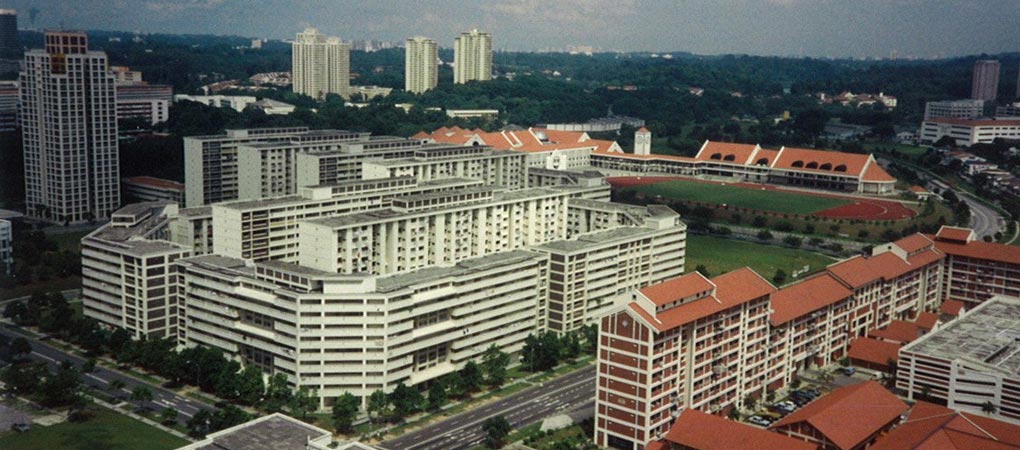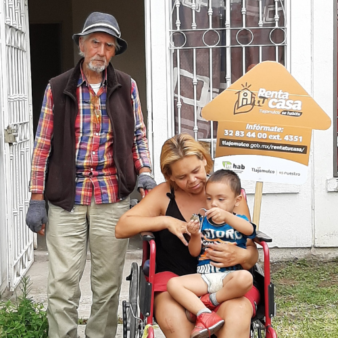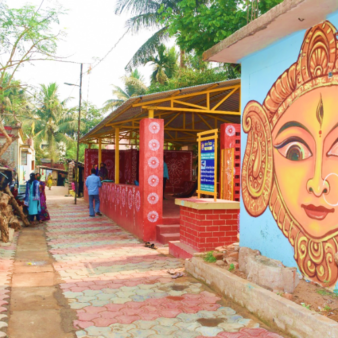Tampines Town is but one of twenty-two new towns in Singapore, built by the Housing and Development Board (HDB). It is however one of the largest and most recent, and brings together many of the lessons that have been learned from experience in previous towns. In 1980, the site of the present Tampines Town was a barren expanse of wasteland, scarred and pitted through sand quarrying. Ten years later the town was completed, covering an area of 960 hectares. It has a population of 280,000 living in 56,000 dwellings. A host of facilities – commercial, social, institutional and recreational – serve this vibrant town. Residents are well served by a library, polyclinic and community centres. The Eastern General Hospital currently under construction will provide more comprehensive medical care. For education, there are several primary and secondary schools as well as the Institute of Technical Education. An efficient transportation network of expressways and trunk roads ensures quick and easy movement, both within the town itself and to other parts of Singapore.
Mechanised construction methods were used in order to speed up the building of the town and to reduce dependency on skilled labour. A factory was set up nearby and operated 24 hours a day to manufacture pre-cast components and there was a mechanised sand quarry to supply the necessary raw materials. Such was the rate of progress that a prefabricated apartment block could be erected in 33 days, something which would have been impossible under the conventional system. Taking advantage of the prefabrication technology, elegant and graceful designs are created through the use of curved facades and contrasting forms. These are further enriched by patterns and tiles in various colours and textures, motifs and finishes.
Given the unavoidable high-density the importance of architectural variety and character in block construction has been recognised. In Tampines, staggered, curved and angled blocks have been used as well as variation in block design and internal layout. Different colours and special features such as pitched roofs, corner protections created at the top of apartment blocks, round balconies, trellises and roof-top gardens are used to create identity in the various neighbourhoods. A picturesque and interesting skyline is also created by the variety of different block heights. Different flat sizes are included within the same block, enabling people from different income groups and backgrounds to live in the same block, thus avoiding the formation of ghettos and encouraging tolerance and respect in a multi-racial community. The first storey of each block is left vacant to create a space known as a void deck. This has environmental and social advantages in that it permits better air movement at ground level, helps to create a less dense image, and provides space for residents to congregate either formally or informally. Where required, child care centres, kindergartens, and other social and communal facilities can be constructed in the void deck.
There are currently eight neighbourhoods in Tampines Town, each having between 5,000 and 6,000 flats and covering an area of 80-100 hectares. These neighbourhoods are identified in terms of the physical design and layout, using certain motifs or colour themes for example. Each neighbourhood is divided into precincts of six to eight residential blocks and each block houses 80 to 120 families. The intimate clusters of apartment blocks are arranged in such a way as to frame an open space which is known as the precinct centre. A network of landscaped walkways and footpaths leads to this space which becomes the focal point for activities within the precinct. This central focal point is supported with communal facilities and children’s playgrounds.
One of the major innovations in the Tampines Town was that of bringing the green areas right into the centre of the town through a series of green fingers, rather than have simply an encircling area of green. This green connector concept weaving the precincts and interlinking them to the park and neighbourhood centre with green areas has proved successful in further fostering a sense of community and belonging. This concept has been repeated in later new towns and extended to older HDB estates undergoing upgrading works.
One of the most impressive aspects of the Singapore towns is the continual maintenance of both environment and buildings. Despite its tropical climate, with more than 2,360 mm of rain per annum, all buildings in the new towns are well maintained, with no sign of peeling paint or defective plastering. All mechanical items, such as lifts, rubbish chutes etc., are serviced regularly and repaired extremely promptly in the case of breakdown. Response times for repairs are carefully monitored, for example, thirty minutes was the longest response time recorded for a lift failure within the last two years. Wherever possible the process of maintenance administration has been computerised and automated to ensure a more speedy and efficient service. All repair requests are recorded on computer, noting time of receipt of call, action taken etc. Records of performance are regularly assessed for possible methods of improving methods or productivity. Management methods are also regularly scrutinised to find more efficient methods. Staff are encouraged to help improve the quality, cost, delivery and safety of HDB’s products and services through Quality Control Circles and Staff Suggestion Schemes.
The green environment is continuously tended. Maintenance of the green and clean setting for the new towns is as important as maintaining the dwelling stock. On the horticulture side, approximately US$10,000 per hectare per annum is spent maintaining the green environment. Pruning of plants and shrubs, weeding and pest control are among the many tasks which need to be carried out.
Prior to 1991, the management and maintenance of the towns was the sole responsibility of HDB. As of 1st March 1991, much of this responsibility was passed to the newly created Town Councils. These Town Councils have been introduced as a means of encouraging residents on the estates to take more responsibility for their homes and environment.
A key aspect of Singapore’s success, in all areas, not only housing, has been its desire to learn and improve its performance. ‘Forward Planning’ is the watchword for HDB, with it doing its best to stay ahead of problems by continuously obtaining feedback through field survey and by identifying and anticipating problems. This is however no easy task and requires constant vigilance and sensitivity. Residents’ reactions to policies and actions in public housing are closely monitored to assist management in their decision making process. Areas of dissatisfaction are looked at particularly closely in order to find solutions and minimise problems in the future.
Provision of decent housing for its citizens has always been a priority for the Singapore Government. The government provides financial assistance to HDB to fund its development programme and other activities. The assistance is in the form of loans and grants.
Government loans given to HDB are of two types:
- Housing Development Loans which finance the building programmes of HDB. These are 20 year loans fixed at two per cent above the floating Central Provident Fund interest rate (currently 3.82 per cent). These loans are repaid through the sale proceeds of flats completed and rental income from tenants.
- Mortgage Financing Loans which finance housing loan facilities made available by HDB to persons wishing to purchase a flat. These Mortgage Financing Loans are 20 year loans at the floating Central Provident Fund interest rate. HDB repays the government loan through collection of instalment repayments of flat purchasers
Grants are provided by the government to cover HDB’s operating losses. Major housing activities relating to the sale, rental and upgrading of flats are loss-making, while other activities such as the rental of commercial and industrial properties result in surpluses. The net operating loss of the housing and other activities is then covered by a grant from the government. In addition, the government also bears the costs of infrastructure and resettlement involved in new developments.
Besides giving grants to HDB, the government also gives grants to the town councils for their estate management activities.
One of the key factors in the successful development of home ownership is the fact that Singapore has a very high savings propensity, in part enforced by the Central Provident Fund which is a compulsory savings scheme for working people. Both employer and employee contribute 20 per cent of the monthly wage to this fund and the employee can use up to 75 per cent of this combined contribution to meet their monthly housing loan repayments. Money accumulated in the fund is used to provide the 20 per cent deposit necessary before buying a flat. Selling prices, rents and service charges are fixed by central government.
There is no unemployment in Singapore and the current labour shortage is giving cause for concern. The subsidy given is related to the size of flat rather than to the income of the household, with smaller flats receiving the larger subsidy. Since lower income households are usually those purchasing smaller flats, such households receive the higher subsidy. The average rental subsidy ranges from 54 per cent to 75 per cent of the market rent, with larger flat sizes receiving greater subsidy.
Singapore is attempting to reduce the role of the state in people’s lives and is encouraging people to become more involved and responsible for decisions that affect their lives. Increasingly, residents are encouraged to become involved in the running of their estates and towns. Town Councils have between 6 and 30 members, and elected Members of Parliament automatically assume the post of Chairman of these councils. They in turn appoint councillors from among residents of their constituencies, particularly those who have a good record of community service. These town councillors are then accountable to their respective constituencies, thus enabling residents to have a greater say in the management of the estate they live in. They are responsible for:
- repairs and maintenance of communal areas and facilities;
- conservancy and cleaning of communal areas;
- landscaping and horticultural works;
- essential maintenance services;
- control of common property;
- collection of service and conservancy charges. In the case of Tampines Town, as in several others, HDB has been appointed as managing agent to carry out this task generating community activities in the town.
In an increasingly urbanised world, cities will come under increasing pressure to house an ever growing population in a comparatively small area. The example provided by Singapore shows how this can be achieved both economically and efficiently, but also with sensitivity shown to the social as well as the economic needs of the population.
Partnership
National government



